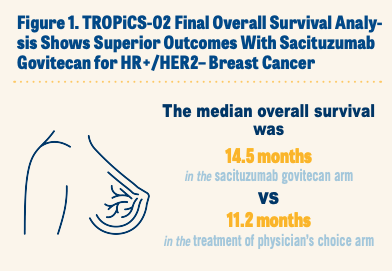TROPiCS-02 Final OS Analysis Shows Superior Outcomes With Sacituzumab Govitecan For HR+/HER2– Breast Cancer
Sacituzumab govitecan improved overall survival vs treatment of physician’s choice in pretreated, endocrine-resistant, hormone receptor–positive, HER2-negative metastatic breast cancer.
Sara M. Tolaney, MD, MPH

The final overall survival (OS) analysis of the phase 3 TROPiCS-02 study (NCT03901339) demonstrated better outcomes with sacituzumab govitecan-hziy (Trodelvy) vs physician's choice of treatment in patient with pretreated, endocrine-resistant, hormone receptor–positive, HER2-negative metastatic breast cancer. Findings were presented at the 2023 ASCO Annual Meeting.1
Findings showed that the median OS in the sacituzumab govitecan arm was 14.5 months (95% CI, 13.0-16.0) vs 11.2 months (95% CI, 10.2-12.6) in the treatment of physician’s choice arm (HR, 0.79; 95% CI, 0.65-0.95; P = .0133). Moreover the 12-, 18-, and 24-month OS rates in each respective arm were 60.9% (95% CI, 54.8%-66.4%) vs 47.1% (95% CI, 41.0%-53.0%), 39.2% (95% CI, 33.4%-45.0%) vs 31.7% (95% CI, 26.2%-37.4%), and 25.7% (95% CI, 20.5%-31.2%) vs 21.1% (95% CI, 16.3%-26.3%).
“With an extended follow-up of approximately 13 months, sacituzumab govitecan continued to demonstrate durable efficacy compared with treatment of physician’s choice chemotherapy, with continued improvements in progression-free survival [PFS] and OS among patients who were pre-treated with endocrine-resistant, metastatic HR-positive breast cancer,” according to lead author Sara M. Tolaney, MD, MPH, during a presentation on the findings.
Tolaney is the chief of the Division of Breast Oncology and associate director at Susan F. Smith Center for Women's Cancers and senior physician at Dana-Farber Cancer Institute, as well as an associate professor of Medicine at Harvard Medical School in Boston, Massachusetts.
The continued OS benefit of sacituzumab govitecan over physician’s choice at a longer follow-up translated to a 21% reduction in risk of death, with more patients remaining alive in the experimental arm at each landmark.

When OS was assessed by Trop-2 expression, investigators reported that patients with an H-score of less than 100 and 100 or more continued to benefit from sacituzumab govitecan with longer follow-up. Among those with an H-score of less than 100, the median OS was 14.9 months (95% CI, 12.7-18.1) in the experimental cohort vs 11.3 months (95% CI, 10.0-13.3) in the therapy of physician’s choice cohort (HR, 0.78; 95% CI, 0.57-1.06). Additionally, those with an H-score of 100 or more had a median OS of 14.4 months (95% CI, 12.7-17.0) vs 11.2 months (95% CI, 9.9-12.7), respectively (HR, 0.82; 95% CI, 0.63-1.08).
The experimental agent was also successful in consistently improving OS in those with HER2-low and HER2 immunohistochemistry (IHC) 0 populations. In the HER2-low population, treatment with sacituzumab govitecan and physician’s choice, respectively, resulted in a median OS of 15.4 months (95% CI, 13.5-19.1) and 11.5 months (95% CI, 10.1-12.9; HR, 0.75; 95% CI, 0.57-0.97). In the HER2 IHC0 population, the median OS was 13.6 months (95% CI, 12.1-16.0) vs 10.8 months (95% CI, 9.2-14.2; HR, 0.85; 95% CI, 0.63-1.14).
The TROPiCS-02 study included a population of patients with metastatic or locally recurrent inoperable, hormone receptor-positive/HER2-negative breast cancer that progressed after the following: at least 1 endocrine therapy, taxane, and CDK4/6 inhibitor in any setting, and 2 to 4 prior lines of chemotherapy in the metastatic setting. Patients also needed measurable disease by RECIST 1.1 criteria.
A total of 543 patients were randomly assigned 1:1 to receive either 10 mg/kg of intravenous sacituzumab govitecan on days 1 and 8 every 21 days (n = 272) or physician’s choice of capecitabine, vinorelbine, gemcitabine, or eribulin (n = 271). Investigators stratified patients based on visceral metastases, endocrine therapy lasting 6 months or more in the metastatic setting, and prior lines of chemotherapy.
The study’s primary end point was PFS by blinded independent central review, with secondary end points including OS, overall response rate (ORR), duration of response (DOR), clinical benefit rate, patient-reported outcomes, and safety. The study also had an exploratory end point of OS by HER2 IHC status.
In the study’s primary analysis,2 patients who received sacituzumab govitecan experienced a significantly better PFS, longer median OS and DOR, and improved ORR than those receiving physician’s choice. Additionally, the second interim analysis highlighted that sacituzumab govitecan continued to yield clinically meaningful efficacy and manageable safety over the comparator arm.3
Ninety-nine percent of patients in each respective arm were female. Most patients in the sacituzumab govitecan and control arms were under 65 years of age (73% vs 75%), White (68% vs 66%), had an ECOG performance status of 1 (57% vs 54%), and had visceral metastases at baseline (95% vs 95%).
The median time from initial metastatic diagnosis to randomization was 48.5 months in the experimental arm vs 46.6 months in the control arm. Most patients in each respective arm had been treated with adjuvant/neoadjuvant chemotherapy (64% vs 68%), received endocrine therapy in the metastatic setting (86% vs 86%), and received a CDK4/6 inhibitor for 12 or fewer months (59% vs 61%).
Investigators noted that sacituzumab govitecan continued to show PFS improvement vs physician’s choice, translating to a reduction in risk of progression or death of 35%. The median PFS was 5.5 months (95% CI, 4.2-6.9) vs 4.0 months (95% CI, 3.0-4.4) in each respective arm (HR, 0.65; 95% CI, 0.53-0.81; P = .0001). The 6-, 12-, and 18-month PFS rates in the sacituzumab govitecan and physician’s choice arms, respectively, were 45.6% (95% CI, 38.9%-52.0%) vs 29.4% (95% CI, 22.9%-36.2%), 21.7% (95% CI, 15.8%-28.3%) vs 8.4% (95% CI, 4.2%-14.5%), and 14.4% (95% CI, 9.1%-20.8%) vs 4.7% (95% CI, 1.3%-11.6%).
Additionally, investigators reported a median PFS of 5.0 months (95% CI, 4.1-6.0) in the sacituzumab govitecan arm vs 4.0 months (95% CI, 2.7-5.6) in the physician’s choice arm among those with an H-score of less than 100 (HR, 0.79; 95% CI, 0.56-1.12). The median PFS was 5.8 months (95% CI, 4.0-8.3) vs 4.1 months (95% CI, 2.3-4.5), respectively, in the H-score of 100 or higher population (HR, 0.61; 95% CI, 0.45-0.83).
Moreover, those with HER2-low disease had a median PFS of 5.8 months (95% CI, 4.1-8.4) following treatment with sacituzumab govitecan compared with 4.2 months (95% CI, 2.8-4.5) with physician’s choice (HR, 0.60; 95% CI, 0.44-0.82). The corresponding median PFS in the HER2 IHC0 population was 5.0 months (95% CI, 3.9-7.2) compared with 3.4 months (95% CI, 1.8-4.2), respectively (HR, 0.70; 95% CI, 0.51-0.98).
In terms of other outcomes, the ORR was 21% among those treated with sacituzumab govitecan and 14% for those treated with physician’s choice. In the sacituzumab govitecan cohort, the complete response (CR) rate was 1%, the partial response (PR) rate was 21%, the stable disease rate was 52%, and the progressive disease rate was 21%. The corresponding rates in the comparator arm were less than 1%, 14%, 39%, and 28%, respectively.
The median DOR was 8.1 months (95% CI, 6.7-8.9) and 5.6 months (95% CI, 3.8-7.9), respectively.
Sacituzumab govitecan’s safety profile was noted as being consistent with previous findings, and investigators observed no new safety signals with the additional follow-up. Common grade 3 or higher treatment-emergent adverse effects in the sacituzumab govitecan group included neutropenia (52%), diarrhea (10%), and anemia (7%) compared with neutropenia (39%), thrombocytopenia (4%), fatigue (4%), and dyspnea (4%) in the physician’s choice group.
References
- Tolaney SM, Bardia A, Marmé F, et al. Final overall survival (OS) analysis from the phase 3 TROPiCS-02 study of sacituzumab govitecan (SG) in patients (pts) with hormone receptor–positive/HER2-negative (HR+/HER2–) metastatic breast cancer (mBC). J Clin Oncol. 2023;41(suppl 16):1003. doi:10.1200/JCO.2023.41.16_suppl.1003
- Rugo HS, Bardia A, Marmé F, et al. Primary results from TROPiCS-02: a randomized phase 3 study of sacituzumab govitecan (SG) versus treatment of physician’s choice (TPC) in patients (Pts) with hormone receptor–positive/HER2-negative (HR+/HER2-) advanced breast cancer. J Clin Oncol. 2022;40(suppl 17):LBA1001. doi:10.1200/JCO.2022.40.17_suppl.LBA1001
- Rugo HS, Bardia A, Marmé F, et al. Overall survival (OS) results from the phase III TROPiCS-02 study of sacituzumab govitecan (SG) vs treatment of physician's choice (TPC) in patients (pts) with HR+/HER2- metastatic breast cancer (mBC). Ann Oncol. 2022;33(suppl 7):S808-S869. doi:10.1016/annonc/annonc1089



